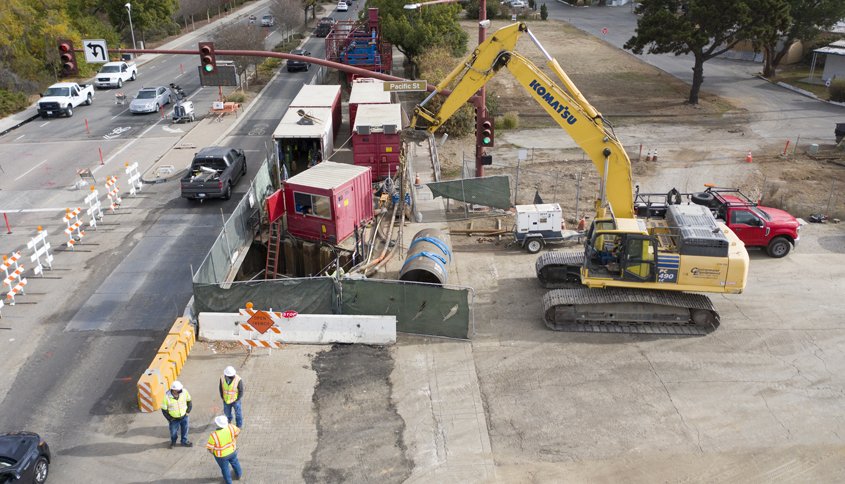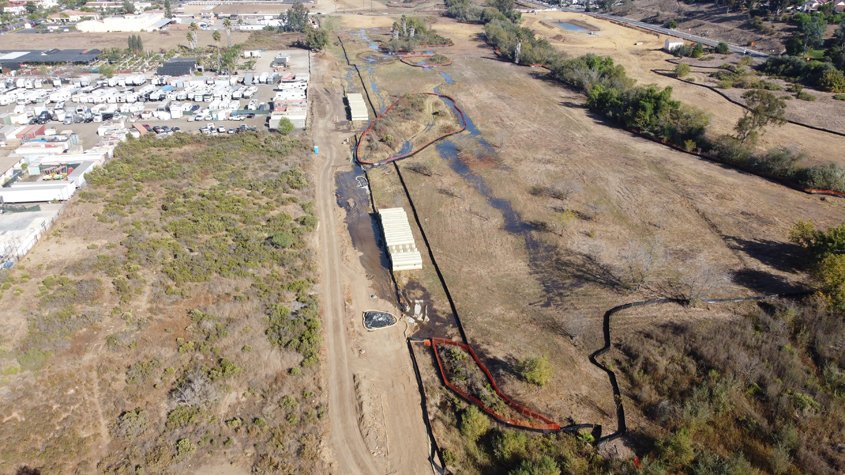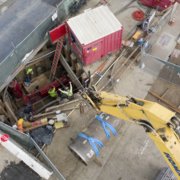San Marcos Interceptor Project Ready for Phase 2 Summer Start
The San Marcos Interceptor Replacement Project remains on schedule, with Phases 1 and 1A completed according to the Vallecitos Water District. The project replaces the District’s 1960s era 21-inch diameter sewer interceptor with more than 12,000-feet of 42-inch diameter sewer pipeline between Twin Oaks Valley Road and Pacific Street.
The Interceptor is a large trunk sewer pipeline receiving and conveying wastewater by gravity to the Encina Wastewater Authority. In Phases 1 and 1A of the project between 2002 and 2014, portions behind the Creekside Marketplace from State Route 78 to Grand Avenue, from Twin Oaks Valley Road to east of Johnston Lane, from Grand Avenue to Via Vera Cruz, and east of Johnson Lane to the south side of State Route 78 were completed.
Phase 2 will complete the remaining 3,400-feet of the westernmost project corridor extending from Via Vera Cruz to Pacific Street. The project budget is $8.5 million. The completion of Phase 2 of the Interceptor project has been in the works for more than 30 years, with the project exchanging numerous hands in planning, design, and construction.
“This is a milestone project for the District both in size and significance,” said Ryan Morgan, capital facilities senior engineer.
State of the art construction technology

Microtunneling made it possible for the Vallecitos Water District to successfully complete the project in under a week with no damage to the existing utilities while also minimizing traffic impacts at San Marcos Boulevard and Pacific Street. Photo: Vallecitos Water District
The project used state-of-the-art trenchless technology to install a 115-ft long tunnel under an existing concrete culvert under the Pacific Street and San Marcos Boulevard intersection. The 42-inch diameter fiberglass reinforced plastic Interceptor sewer was installed inside a 60-inch diameter steel casing pipe.
Using a process known as “microtunneling,” contractor TC Construction and sub-consultant JW Fowler used a MicroTunnel Boring Machine (MTBM) inside an excavation in the eastbound lanes of San Marcos Boulevard and be received in a smaller excavation in the westbound lanes of San Marcos Boulevard at Pacific Street.
The MTBM is larger than 60-inches in diameter to be large enough to bore through native soils, rock, and backfill along the Interceptor alignment. The new tunnel’s wall is pressurized internally using hydraulic fluids before the steel casing is permanently installed. The MTBM is remote-controlled by an operator on the surface and is laser-guided to ensure it stays within the designed horizontal and vertical alignment (line and grade).
The MTBM’s high level of accuracy makes it especially useful when a project needs to avoid conflicts with existing underground utility lines, including a 16-inch diameter high-pressure San Diego Gas & Electric gas line in this project. The microtunnel installation was a 24-hour, 7-day-a-week process.
The microtunnel allowed the District to “thread the needle,” and the tunnel was completed in under a week (plus setup). There was no damage to any of the existing utilities in San Marcos Boulevard, and traffic impacts were minimized.
Project completion nearing this summer

The San Marcos Interceptor project required special mitigating measures and biological monitoring for construction during bird nesting season between February 15 and September 15 along San Marcos Creek. Photo: Vallecitos Water District
The Interceptor project required biological monitors and archeological monitors for work adjacent to San Marcos Creek or predetermined environmental sensitive areas. Special mitigation measures and biological monitoring were required for construction during bird nesting season between February 15 and September 15. Additionally, tribal paleological monitors from Native American tribes of significance in the area were represented during excavation work in the creek.
The final leg of the project will begin in the easements adjacent to the creek between Via Vera Cruz and McMahr. Construction completion is expected in June 2021.
This replacement project was originally identified in the District’s 1991 Master Plan and has been phased to be completed prior to City of San Marcos development of the Creek District.
(Editor’s note: The Vallecitos Water District is one of the San Diego County Water Authority’s 24 member agencies that deliver water across the metropolitan San Diego region.)




